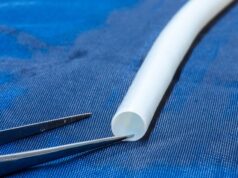
Clinical outcomes of Humacyte’s investigational Human Acellular Vessel (HAV) were presented at the Military Health System Research Symposium in Kissimmee, Florida (Aug. 14–17), following a year-long humanitarian program in Ukraine. The bioengineered, implantable human tissue-based device was provided to five hospitals on the frontlines of the Ukrainian war to treat traumatic vascular injuries beginning in June 2022.
War injuries in Ukraine have led to tens of thousands of amputations, many of which occur because blood flow cannot be restored after the injury, the company outlined in a press release. As of July 2023, the HAV has been used to treat 19 patients in the eastern European country suffering from a range of traumatic vascular injuries, including gunshots, shrapnel, blasts and industrial accidents.
Clinicians reported that the rate of success in treating patients with the HAV was high, Humacyte reported, with an observed 30-day HAV patency (presence of blood flow) of 95%. At 30 days after treatment with the HAV, the limb salvage rate was 100%, meaning no amputations occurred in patients treated with the bioengineered vessel. In addition, there was 100% patient survival and no cases of infection of the HAV. There was one patient whose HAV had to be removed due to shrapnel-related bleeding.
“The novel bioengineered, off-the-shelf HAV provides time to the surgeon and patient,” said Oleksandr Sokolov, MD, a Ukrainian vascular surgeon and HAV implanter in the humanitarian program. “It has the potential to be a significant advancement in treating life-threatening combat vascular injuries.”
Humacyte’s humanitarian program was initiated in May 2022, when the company provided investigational HAVs to hospitals in Vinnytsia, Dnipro, Odessa, Kyiv and Kharkiv, in response to Ukrainian surgeon requests. Humacyte worked closely with the Food and Drug Administration (FDA) and the Ukrainian Ministry of Health to obtain approval for the program. The company then subsequently trained Ukrainian surgeons by video conference on how to implant the HAV.
The HAV, a regenerative medicine product candidate, is designed to provide surgeons with a universally implantable, bioengineered human vessel. It is intended to be available to the surgeon immediately and provide a potentially life- and limb-saving option in circumstances where synthetics are not indicated and autologous vein is not feasible. Designed to be off-the-shelf, the HAV has the potential to save valuable time and reduce complications like amputations and tissue loss, Humacyte pointed out. Additionally, the HAV is comprised of the same tissue that makes up natural human vessels, thereby having the potential to repopulate with the patient’s own cells.
Clinical results suggest that the HAV is durable and highly infection-resistant, and therefore may be well suited for treating the contaminated wounds created by major wartime blast and shrapnel injuries, Humacyte said in the press release.
The new data from the frontlines in Ukraine will be included as part of Humacyte’s Biologics License Application (BLA) to the FDA, which is planned for the fourth quarter of 2023, the company said. The planned BLA will build on results from Humacyte’s pivotal trial studying the HAV in treating patients with vascular injury in the extremities, which recently completed enrollment. The HAV also received the FDA’s Regenerative Medicine Advanced Therapy (RMAT) designation in May 2023 for urgent arterial repair following extremity vascular trauma.
The HAV has accumulated over 1,000 patient-years of experience worldwide in a series of clinical trials in multiple indications, including vascular trauma repair, arteriovenous access for hemodialysis, and peripheral arterial disease. It is an investigational product and has not been approved for sale by the FDA or any other regulatory agency.












